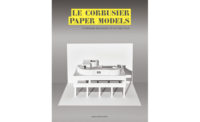CHANDIGARH'S Le CORBUSIER:
THE STRUGGLE FOR MODERNITY IN POSTCOLONIAL INDIA
By Vikramaditya Prakash
Why do we need another book about Le Corbusier? Since well before his death in 1965, the prolific French-Swiss architect has been the center of a virtual industry of publications about his work. In the case of Prakash’s book, the answer is that while Le Corbusier as the hero (or villain) of Western architecture is a story that has often been told, his ambiguous standing outside of Europe and North America has seldom been thoughtfully considered. Although the Punjabi provincial capital of Chandigarh has not been the model for future Indian urbanization that Le Corbusier intended, his deep interest in the problem of creating a monumental government complex for a new state in the first modern postcolonial nation has had many consequences for architecture around the world.
Prakash intends his book to be accessible not only to architects but also, as he puts it, to "multiple audiences in history and theory," including those interested in the history of South Asia in particular. His own background as the son of one of the Indian architects involved with the design of Chandigarh has both advantages and disadvantages. While he tries to keep in mind that the general reader has little knowledge of Le Corbusier’s work, modern India, or postcolonial theory, the book in fact requires some knowledge of all three to be appreciated. Nevertheless, Chandigarh’s Le Corbusier offers a welcome introduction to the complexities of the intersections between Modern art and architecture and the non-Western world. Colonialist appropriation and condescension were usually part of such encounters, yet at the same time Le Corbusier’s work in India ushered in a new paradigm for architecture whose effects in India still resonate. Charles Correa’s assertion that perhaps someday Le Corbusier "will be acknowledged … as the greatest Indian architect of them all" is now a widely shared view. Thousands of buildings ranging from the works of Correa and another member of the Chandigarh team, Balkrishna Doshi, to those of less well known figures such as Achyut Kanvinde, Shivnath Prasad, Jeet Malhotra, Harbinder Singh Chopra, Rajinder Kumar, and dozens of others testify to Le Corbusier’s influence on Indian architecture, which is now a historical fact regardless of one’s opinion of his work and legacy.
Prakash notes that for Prime Minister Jawaharlal Nehru, Le Corbusier’s patron, the old Indian nationalist opposition between "Indian" and "European" was replaced by a dialectic between "tradition" and "modernity." Like Nehru, Le Corbusier was interested in negotiating between these newly articulated polarities, rather than simply imposing a European model, which explains much of the veneration he inspired in India. As postcolonialist views have emerged, this veneration now appears to some as an embarrassing relic of colonialism. It is to Prakash’s credit that he tries to steer between glib dismissal and adulation as he moves beyond the familiar oppositions of awestruck Corbu-worship and easy postmodern rejection. At the same time, there is something a little disappointing about a book on Chandigarh that for the most part still traverses the familiar visual terrain of the capitol complex, rather than looking more broadly at the phenomenon of its influence in India.
Le CORBUSIER: ARCHITECT OF THE TWENTIETH CENTURY
By Kenneth Frampton
The second of two books the eminent Columbia University critic and historian has published recently on Le Corbusier, this volume consists mainly of recent large-format photographs by Roberto Schezen. They amply illustrate 17 well-known projects, which range from the architect’s Purist villas of the 1920s to the late work in France and India.
Schezen’s photographs are accompanied by short texts that describe the circumstances of the design of each work and, in some cases, the later vicissitudes of the buildings. The book is a useful visual resource, and the texts concisely synthesize a great deal of historical material from other sources, much of it still only available in French. These brief chapters are clear and informative, and the book serves as a good introduction for those unfamiliar with Corbu’s work.
One can argue with some of the projects omitted: the Curruchet House in Argentina (1949), the "regionalist" houses in France from the 1930s, and the Brazilian Ministry of Education and Health in Rio (1936–42), designed with Oscar Niemeyer, Lúcio Costa, Affonso Reidy. The featured works, however, which include the Villa Savoye, the Swiss Pavilion dormitory, the Unité in Marseilles, Ronchamp, Chandigarh, and the monastery of La Tourette, are well documented, and the photographs reveal new aspects of Le Corbusier’s widely varying design responses over his long career.
The book also includes many of Corbu’s conceptual sketches, which help to explain the ideas behind the work and address issues of site and climate in immediately comprehensible ways. Le Corbusier: Architect of the Twentieth Century makes a strong case for the master’s continuing importance to architectural design in the 21st century.





Post a comment to this article
Report Abusive Comment